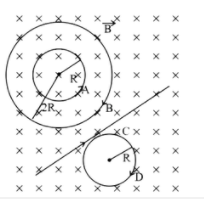
Q. C & D are
NH3&Be(OH)2
Be(OH)2&NH3
NH3&HNO3
Be(OH)2&BeO2
The correct Answer is:B
Step by step video & image solution for Q. C & D are by Chemistry experts to help you in doubts & scoring excellent marks in Class 12 exams.
Updated on:21/07/2023Topper's Solved these Questions
- THE S-BLOCK ELEMENTSBOOK - AAKASH INSTITUTECHAPTER - THE S-BLOCK ELEMENTSEXERCISE - Assignment (Section-E)
7 Videos
- THE S-BLOCK ELEMENTSBOOK - AAKASH INSTITUTECHAPTER - THE S-BLOCK ELEMENTSEXERCISE - Assignment (Section-F)
3 Videos
- THE S-BLOCK ELEMENTSBOOK - AAKASH INSTITUTECHAPTER - THE S-BLOCK ELEMENTSEXERCISE - Assignment (Section-C)
11 Videos
- THE P-BLOCK ELEMENTSBOOK - AAKASH INSTITUTECHAPTER - THE P-BLOCK ELEMENTSEXERCISE - Assignment Section-J)
16 Videos
- THE SOLID STATE BOOK - AAKASH INSTITUTECHAPTER - THE SOLID STATE EXERCISE - Assignment (SECTION - D) (ASSERTION-REASON TYPE QUESTION)
20 Videos
Similar Questions
ABCD is a parallelogram. A circle through A, B is so drawn that it intersects AD at P and BC at Q. Prove that P, Q, C and D are concyclic.
View Solutionp AND q are any two points lying on the sides DC and AD respectively of a parallelogram ABCD. Show that ar(APB)=ar (BQC).
View SolutionABCD is a rhombus and P,Q,R,S are the mid-points of AB,BC,CD,DA respectively. Prove that PQRS is a rectangle.
View SolutionLet AB and CD are two parallel chords of circle whose radius is 5 units. If P and Q are mid points of AB and CD respectively such that PA.PB=9,QC.QD=16, then distance betweẹn AB and CD is
View SolutionTwo triangle ABC and DBC lie on the same side of the base BC . From a point P on BC,PQAB AND PRBD ARE DRAWN. They meet AC in Q and DC in R respectively. Prove that QRAD.
View SolutionABCD is a trapezium in which ABDC . P and Q are points on sides AD and BC such that PQAB . If PD=18 , BQ=35 and QC=15 , find AD .
View SolutionFour particles A, B, and C and D of masses mA,mB,mBandmD respectively, follow the paths shown in the figure, in a uniform magnetic field. Each particle moving with same speed. QA,QB,QCandQD are the specific charge of particles A, B, C and D respectively (assume that the motion of each particle is in the same plane perpendicular to the magnetic field).

View SolutionFour point charges qA=2μC,qB=−5μC,qC=−2μCandqD=−5μC are located at the corners of a square ABCD of side 10 cm. What is the force on a charge of 1μC placed at the center of the square ?
View SolutionABCD is a trapezium such that AB and CD are parallel and BC⊥CD . If ∠ADB=θ,BC=pandCD=q , then AB is equal to (1) p2+q2cosθpcosθ+qsinθ (2) p2+q2p2cosθ+q2sinθ (3) (p2+q2)sinθ(pcosθ+qsinθ)2 (4) (p2+q2)sinθpcosθ+qsinθ
View SolutionIn Figure, ABCD and PQRC are rectangles and Q is the mid-point of AC . Prove that DP=PC (ii) PR=12 AC
View Solution
